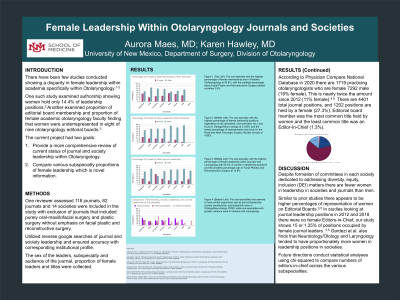Professional and Personal Development
(1111) Female Leadership Within Otolaryngology Journals and Societies
Monday, September 30, 2024
12:00 PM - 1:00 PM EDT

Has Audio
Disclosure(s):
Aurora M. Maes, MD: No relevant relationships to disclose.
Introduction: There is literature showing a disparity in female leadership present within academic journals in otolaryngology; research on how this inequity exists or is evolving in various subspecialties is sparse. This study aims to provide a comprehensive review of journal and society academic leadership within otolaryngology by comparing various subspecialties and the representative proportions of female leadership.
Methods: A reviewer assessed 118 journals for titles of journal, editorial board leadership, journal impact factor, using journal official websites and society websites. A total of 82 journals and 14 societies were included. The gender/sex, subspecialty or generalist audience of the journal or society, and proportion of female leaders and their titles were collected.
Results: Within otolaryngology societies, there are a total of 408 female leaders. Of them, 78.9% have the title of council or committee member; other titles including president (2.2%), vice president (1.7%), and chair (4.66%) make up smaller proportions of female leadership. Laryngology (25.6%) and head and neck societies (29.8%) have similar percentages of female leadership. Pediatric otolaryngology (45.2%) and otology/neurotology (75%) societies had the highest proportions of female leadership.
There are a total of 1,203 females in journal leadership positions. The majority of titles were editorial board member (63.18%), and a small percentage were editor in chief (1.25%). Laryngology (55.73%) represented the highest proportion of female journal leadership; the lowest was head and neck (18.15%). Subspecialties were further analyzed by title with general otolaryngology and head and neck Journals having higher percentages of editors in chief (2.07% and 2.02% respectively) compared to pediatric otolaryngology and rhinology journals (0.96% and 1.54%).
Conclusions: Despite efforts by numerous subspecialties to establish committees to address the sex/gender disparity in otolaryngology, there remains inequities in female leadership within the highest-ranking titles of academia. These are reflected in various subspecialties.

Aurora M. Maes, MD
Resident
University of New Mexico
Albuquerque, New Mexico, United States- KH
Karen Hawley, MD
Associate Professor
University of New Mexico
Albuquerque, New Mexico, United States
